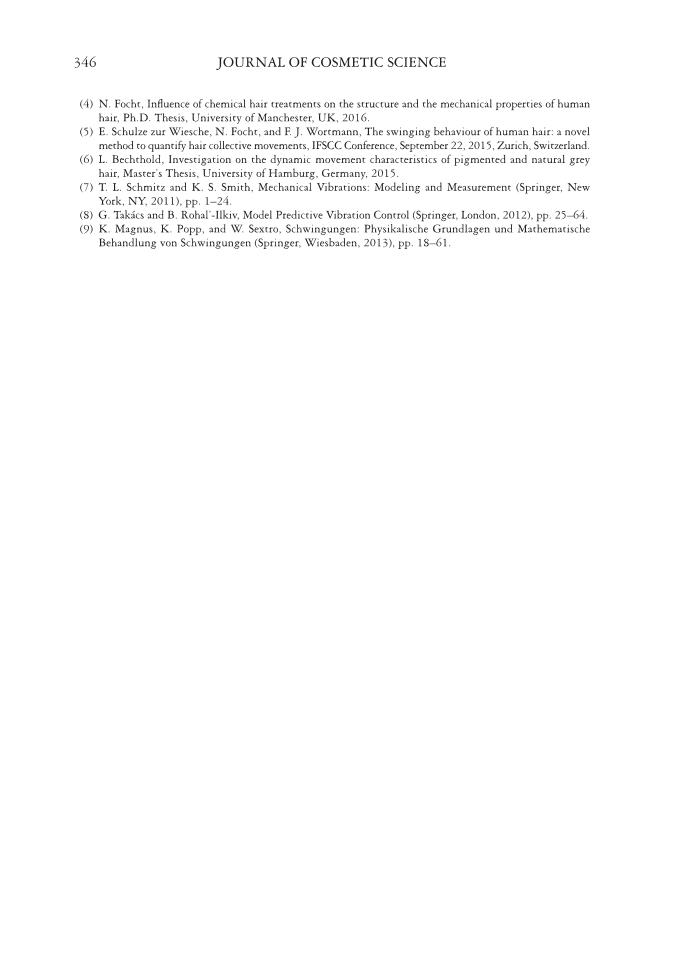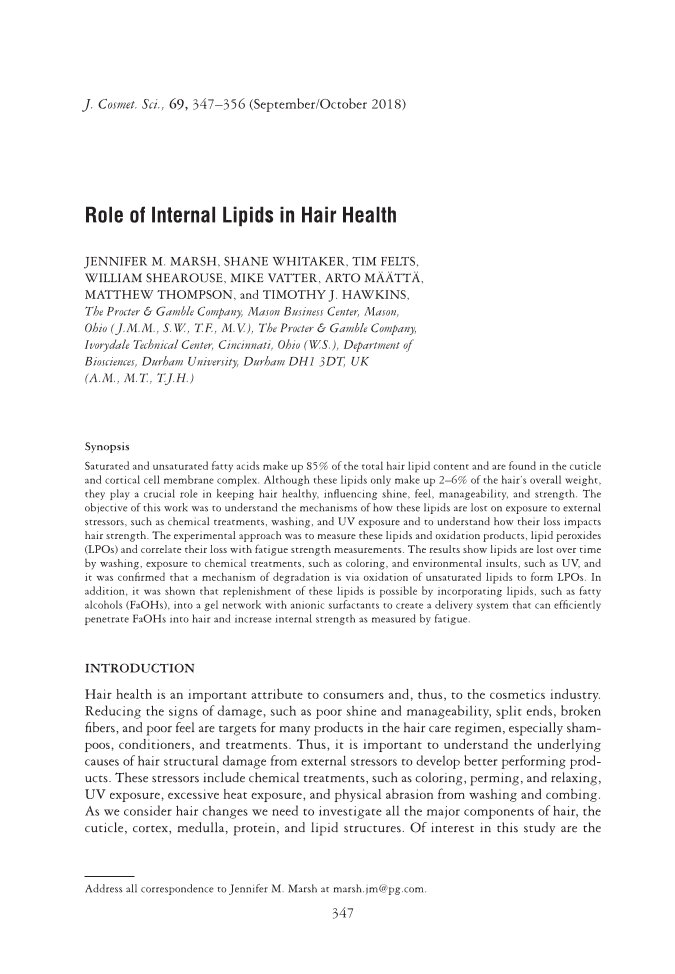JOURNAL OF COSMETIC SCIENCE 346 (4) N. Focht, Infl uence of chemical hair treatments on the structure and the mechanical properties of human hair, Ph.D. Thesis, University of Manchester, UK, 2016. (5) E. Schulze zur Wiesche, N. Focht, and F. J. Wortmann, The swinging behaviour of human hair: a novel method to quantify hair collective movements, IFSCC Conference, September 22, 2015, Zurich, Switzerland. (6) L. Bechthold, Investigation on the dynamic movement characteristics of pigmented and natural grey hair, Master’s Thesis, University of Hamburg, Germany, 2015. (7) T. L. Schmitz and K. S. Smith, Mechanical Vibrations: Modeling and Measurement (Springer, New York, NY, 2011), pp. 1–24. (8) G. Takács and B. Rohal’-Ilkiv, Model Predictive Vibration Control (Springer, London, 2012), pp. 25–64. (9) K. Magnus, K. Popp, and W. Sextro, Schwingungen: Physikalische Grundlagen und Mathematische Behandlung von Schwingungen (Springer, Wiesbaden, 2013), pp. 18–61.
J. Cosmet. Sci., 69, 347–356 (September/October 2018) 347 Role of Internal Lipids in Hair Health JENNIFER M. MARSH, SHANE WHITAKER, TIM FELTS, WILLIAM SHEAROUSE, MIKE VATTER, ARTO MÄÄTTÄ, MATTHEW THOMPSON, and TIMOTHY J. HAWKINS, The Procter & Gamble Company, Mason Business Center, Mason, Ohio ( J.M.M., S.W., T.F., M.V.), The Procter & Gamble Company, Ivorydale Technical Center, Cincinnati, Ohio (W.S.), Department of Biosciences, Durham University, Durham DH1 3DT, UK (A.M., M.T., T.J.H.) Synopsis Saturated and unsaturated fatty acids make up 85% of the total hair lipid content and are found in the cuticle and cortical cell membrane complex. Although these lipids only make up 2–6% of the hair’s overall weight, they play a crucial role in keeping hair healthy, infl uencing shine, feel, manageability, and strength. The objective of this work was to understand the mechanisms of how these lipids are lost on exposure to external stressors, such as chemical treatments, washing, and UV exposure and to understand how their loss impacts hair strength. The experimental approach was to measure these lipids and oxidation products, lipid peroxides (LPOs) and correlate their loss with fatigue strength measurements. The results show lipids are lost over time by washing, exposure to chemical treatments, such as coloring, and environmental insults, such as UV, and it was confi rmed that a mechanism of degradation is via oxidation of unsaturated lipids to form LPOs. In addition, it was shown that replenishment of these lipids is possible by incorporating lipids, such as fatty alcohols (FaOHs), into a gel network with anionic surfactants to create a delivery system that can effi ciently penetrate FaOHs into hair and increase internal strength as measured by fatigue. INTRODUCTION Hair health is an important attribute to consumers and, thus, to the cosmetics industry. Reducing the signs of damage, such as poor shine and manageability, split ends, broken fi bers, and poor feel are targets for many products in the hair care regimen, especially sham- poos, conditioners, and treatments. Thus, it is important to understand the underlying causes of hair structural damage from external stressors to develop better performing prod- ucts. These stressors include chemical treatments, such as coloring, perming, and relaxing, UV exposure, excessive heat exposure, and physical abrasion from washing and combing. As we consider hair changes we need to investigate all the major components of hair, the cuticle, cortex, medulla, protein, and lipid structures. Of interest in this study are the Address all correspondence to Jennifer M. Marsh at marsh.jm@pg.com.
Purchased for the exclusive use of nofirst nolast (unknown) From: SCC Media Library & Resource Center (library.scconline.org)









































































































